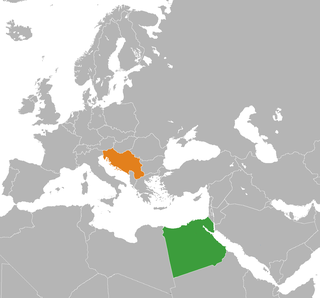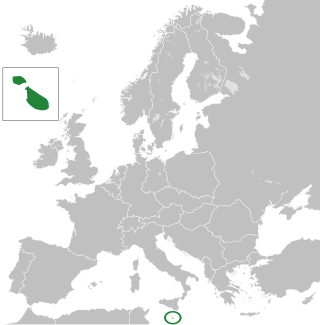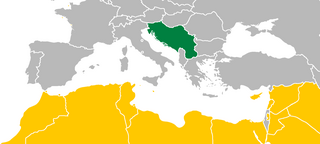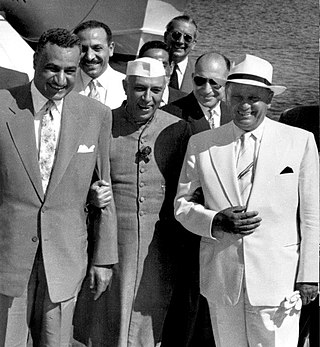
The Brijuni or the Brijuni Islands are a group of fourteen small islands in the Croatian part of the northern Adriatic Sea, separated from the west coast of the Istrian peninsula by the narrow Fažana Strait. The largest island, Veliki Brijun Island, (5.6 km2), lies 2 kilometres off the coast. The second-largest island is Mali Brijun with an area of 1.07 square kilometres (0.41 sq mi), and twelve much smaller islands. Known for their scenery, the islands are a holiday resort and a Croatian National Park.

The Socialist Federal Republic of Yugoslavia was a founding member of the Non-Aligned Movement, an international groupation established to maintain independence of countries beyond Eastern and Western Bloc from the major Cold War powers. Belgrade, the capital of Yugoslavia, hosted the First Summit of the Non-Aligned Movement in September 1961 and the Ninth Summit in September 1989.

Indonesia–Yugoslavia relations were historical foreign relations between now split-up Socialist Federal Republic of Yugoslavia and Indonesia. Both countries were founding member states of the Non-Aligned Movement. Two countries established formal diplomatic relations in 1954. First diplomatic documents were exchanged as early as 1947. Breakup of Yugoslavia, one of the founding and core members of the Non-Aligned Movement, brought into question the very existence of the Movement which was preserved only by politically pragmatic chairmanship of Indonesia.

Egypt–Yugoslavia relations were historical foreign relations between Egypt and now break-up Yugoslavia. Both countries were founding members and prominent participants of the Non-Aligned Movement. While initially marginal, relations between the two Mediterranean countries developed significantly in the aftermath of the Soviet-Yugoslav split of 1948 and the Egyptian revolution of 1952. Belgrade hosted the Non-Aligned movement's first conference for which preparatory meeting took place in Cairo, while Cairo hosted the second conference. While critical of certain aspects of the Camp David Accords Yugoslavia remained major advocate for Egyptian realist approach within the movement, and strongly opposed harsh criticism of Cairo or proposals which questioned country's place within the movement.

India–Yugoslavia relations were historical foreign relations between India and now split-up Socialist Federal Republic of Yugoslavia. Yugoslavia established full diplomatic relations with India on 5 December 1948 following the 1948 Tito–Stalin split. Initially two countries developed their relations at the UN Security Council in 1949 during their shared membership. In the period of the Cold War both countries were the founders and among core members of the Non-Aligned Movement.

Malta–Yugoslavia relations were historical foreign relations between Malta and now split-up Socialist Federal Republic of Yugoslavia. Together with Cyprus, both countries belonged to the small group of European and Mediterranean member states of the Non-Aligned Movement during the Cold War, group which itself part of the larger group of neutral and non-aligned European countries. The Non-aligned countries in Europe advocated for relaxation of divisions, rejection of superpowers' spheres of influence and for cooperation of diverse countries on the continent. During the Cold War period all three Non-Aligned Euro-Mediterranean countries developed close economic cooperation with the European Economic Community.

Vietnam–Yugoslavia relations were historical foreign relations between Vietnam and now split-up Socialist Federal Republic of Yugoslavia. Two countries established formal bilateral relations in 1957. Relations were predominantly positive due to positive public image of Vietnam in Yugoslavia which was result of Vietnamese resistance to foreign domination and shared membership in the Non-Aligned Movement.
Egypt was one of the founding members of the Non-Aligned Movement (NAM). The preparatory meeting for the First NAM Conference in Belgrade was held in Cairo between 5 and 12 June 1961. The first NAM conference was cosponsored between President of Egypt Gamal Abdel Nasser and President of Yugoslavia Josip Broz Tito who sent joint letter to other leaders during their bilateral meeting in Egypt. Cairo hosted the Second Conference in October 1964 attended by forty-seven countries while Egyptian Red Sea resort Sharm el-Sheikh hosted the Fifteenth Conference in 2009. At the time of the Sharm el-Sheikh Conference 118 countries participated in the activities of the movement with some other countries having the observer status. 55 heads of state attended the 2009 conference. Official Egyptian state institutions view the movement as the broadest and the most important framework for developing countries to coordinate their stances on issues on the agenda of the United Nations and to act together against unilateral policies.
During the Cold War period former Southeast European country of the Socialist Federal Republic of Yugoslavia established and maintained significant political, cultural and economic exchanges and relations with newly independent African states. While majority of multilateral exchanges were organized via Non-Aligned Movement and the United Nations, significant cooperation developed with the Organisation of African Unity as well, predecessor to contemporary African Union. Yugoslavia was the only non-African country which participated in funding of the Liberation Committee of the Organisation of African Unity. While being a uniquely involved in the workings of the body the country nevertheless preferred bilateral relations with individual liberation movements. The Organisation of African Unity included the Non-Alignment principle in its charter while Yugoslavia consider the organisation to be the only legitimate representative for the entire African continent throughout the Cold War era. Yugoslavia therefore followed common OAU line in its own policies towards issues in Africa.

Cambodia–Yugoslavia relations were historical foreign relations between Cambodia and now split-up Socialist Federal Republic of Yugoslavia. The first official meeting between Norodom Sihanouk and President of Yugoslavia Josip Broz Tito happened in 1956 on Brijuni islands in Yugoslav constituent Socialist Republic of Croatia. Till 1976 Sihanouk visited Yugoslavia on five occasions while President Tito visited Cambodia twice. Cambodia was one of the countries represented at the 1961 Summit Conference of Heads of State or Government of the Non-Aligned Movement in Belgrade, the first conference of the Non-Aligned Movement. Yugoslavia credited and participated in construction of the Kirirom 1 Hydropower Dam which was completed in 1969.

Summit Conference of Heads of State or Government of the Non-Aligned Movement on 1–6 September 1961 in Belgrade, Yugoslavia was the first conference of the Non-Aligned Movement. A major contributing factor to the organization of the conference was the process of decolonization of a number of African countries in the 1960s. Some therefore called it the ″Third World's Yalta″ in reference to 1945 Yalta Conference.

Third Conference of the Non-Aligned Movement on 8–10 September 1970 in Lusaka, Zambia was the third conference of the Non-Aligned Movement. A preparatory meeting of Foreign Ministers drafted a number of resolutions which were considered by the Summit Conference. President of Zambia Kenneth Kaunda opened the conference by underlining non-alignment as "the natural choice at the time of increased hostility created by ideological conflicts in the bipolar world"

The Non-Aligned Movement (NAM) is a forum of 120 countries that are not formally aligned with or against any major power bloc. It was founded with the view to advancing interests of developing countries in the context of Cold War confrontation. After the United Nations, it is the largest grouping of states worldwide.

60th Anniversary Additional Commemorative Non-Aligned Meeting is the 11–12 October 2021 Non-Aligned Movement commemorative meeting taking place in Belgrade, Serbia. The meeting was organized by the Ministry of Foreign Affairs of Serbia, and cohosted with Azerbaijan, in commemoration to the 1st Summit of the Non-Aligned Movement. President Ilham Aliyev made opening speech in a video format. Minister of Foreign Affairs of Serbia Nikola Selaković underlined that his county's strategic and essential goal is membership in the European Union, but that Serbia will not give up on its traditional friends which are not only Russia or China but all member states of the Non-Aligned Movement. While reflecting on historical achievements Indian representative Meenakshi Lekhi invited honest introspection if movement is to keep its relevance and called unnamed member states to avoid insistence on divisive issues and bilateral score-settling which make NAM increasingly ineffective. Participants vocally decried the disparity in vaccine access between developed and developing countries.

The 1984 Mediterranean Non-Aligned Countries Ministerial Meeting held in Valletta, Malta on 10 and 11 September 1984 was the first ever ministerial meeting of the Non-Aligned countries from the Mediterranean region. The idea of the organizer was to host an event with restricted number of participants from the Mediterranean basin where common concerns will be addressed. At the time, the group included Southern Mediterranean and Levantine Arab countries and only three European Non-Aligned countries of Malta, Cyprus and SFR Yugoslavia. The meeting concluded that freedom of the seas in a closed sea like Mediterranean should be exercised for peaceful purposes without military naval deployment, especially by non-Mediterranean countries. The event was envisaged as a preliminary collective effort by the countries concerned at the achievement of the peace in the region. The following meeting of the group was organized in 1987 on the Brijuni Islands in the Yugoslav constituent Socialist Republic of Croatia. The final document of the meeting was subsequently reaffirmed by the NAM movement as a whole when at the 1985 Luanda foreign ministers meeting the final document of that meeting called states of the world to respect the 1984 Valletta Declaration.

4th Summit of the Non-Aligned Movement took place on 5–9 September 1973 in Algiers, the capital city of Algeria. The event took place in the Palace of Nations outside of the capital city. The general agenda for the summit was initially defined at the 1973 ministerial meeting in Kabul where Algerian delegation welcomed primary contribution of Guyana, India and SFR Yugoslavia. 76 countries in total participated in the summit calling upon the United States and the Soviet Union not to take important decisions on disarmament, world trade or the world monetary system without the effective participating on the Third World.

Malta was the third European member state of the Non-Aligned Movement joining it in 1973. The country remained a part of the movement until 2004 when one of the requirements of the 2004 enlargement of the European Union was for Malta to leave the Non-Aligned Movement. European integration process therefore affected and limited further Maltese integration and engagement with its Non-Aligned neighbouring states.

The "Josip Broz Tito" Art Gallery of the Nonaligned Countries was an art gallery in Titograd in the Socialist Republic of Montenegro, one of the federal subjects of the Socialist Federal Republic Yugoslavia. It was the only art institution established directly by the Non-Aligned Movement's decision.

The 1985 Non-Aligned Foreign Ministers Conference was held in Luanda, capital of Angola from 4 to 7 September with the senior officials meeting being held on 2 and 3 September. The organization of the conference in the circumstances of the ongoing Angolan Civil War was described as a large scale organizational undertaking and a considerable achievement.

The Brioni Meeting between President of Egypt Gamal Abdel Nasser, Prime Minister of India Jawaharlal Nehru and their host President of Yugoslavia Josip Broz Tito took place on the Brijuni Islands, PR Croatia, FPR Yugoslavia on 19 July 1956. The conference was one of the major initiatives among countries unaffiliated to neither Eastern or Western Bloc on their road to the establishment of the Non-Aligned Movement at the 1961 Belgrade Summit. 120 Yugoslav and foreign journalists followed the meeting.





















